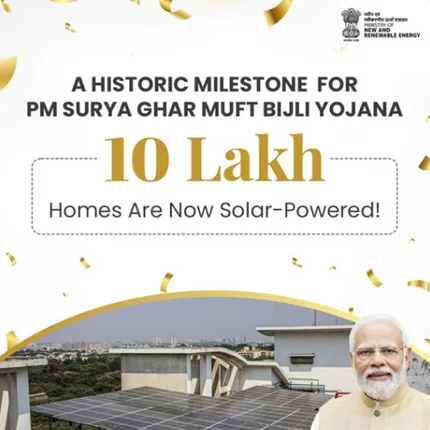NEW DELHI, March 13: The PM Surya Ghar: Muft Bijli Yojana (PMSGMBY), the world’s largest domestic rooftop solar initiative, has reached a historic milestone, with 10 lakh homes now powered by solar energy as of March 10, 2025, according to a statement from the Ministry of New and Renewable Energy. Launched by Prime Minister Narendra Modi on February 13, 2024, the scheme is transforming India’s energy landscape and has already received 47.3 lakh applications. The government has disbursed Rs. 4,770 crore in subsidies to 6.13 lakh beneficiaries, making solar energy more accessible for Indian households.
A key aspect of the scheme is the provision of easy financing options, including collateral-free loans up to Rs. 2 lakh at a subsidized interest rate of 6.75% from 12 Public Sector Banks. So far, 3.10 lakh loan applications have been received, with 1.58 lakh sanctioned and 1.28 lakh disbursed, ensuring financial inclusion. The scheme has a swift 15-day subsidy transfer process, enabling many households to enjoy zero electricity bills.
Significant progress has been made across various states in implementing the scheme. Chandigarh and Daman & Diu have achieved 100% of their rooftop solar targets for government buildings, while states like Rajasthan, Maharashtra, Gujarat, and Tamil Nadu have made significant contributions. Gujarat leads with 3,51,273 solar installations, benefiting 41.47% of the total households. Kerala and Uttar Pradesh follow with 7.73% and 8.69%, respectively.
The PM Surya Ghar scheme offers several benefits, including free electricity through subsidized rooftop solar panels, significantly reducing energy costs. The widespread adoption of solar power is expected to save the government Rs. 75,000 crore annually in electricity costs and reduce carbon emissions. Each installation offsets carbon emissions equivalent to planting 100 trees, contributing to India’s efforts toward a cleaner, self-reliant future.
Subsidy amounts are based on household consumption, with subsidies ranging from Rs. 30,000 to Rs. 78,000 for solar plants ranging from 1 kW to 3 kW or more. Households can apply for subsidies via the National Portal, which helps with vendor selection, system sizing, and other details.
The scheme is projected to add 30 GW of solar capacity through residential rooftop installations by 2027, playing a crucial role in meeting India’s renewable energy targets. Over the 25-year lifespan of these systems, the initiative is expected to generate 1000 billion units (BU) of electricity while reducing CO2 emissions by 720 million tonnes. It is also anticipated to create 17 lakh direct jobs, supporting the government’s Aatmanirbhar Bharat initiative. The use of domestically produced solar modules and cells is further strengthening India’s renewable energy ecosystem.
A unique feature of the scheme is the establishment of “Model Solar Villages,” one selected per district to demonstrate solar energy adoption and promote energy self-reliance. Each selected village will receive Rs. 1 crore to set a benchmark for solar energy use across India.

